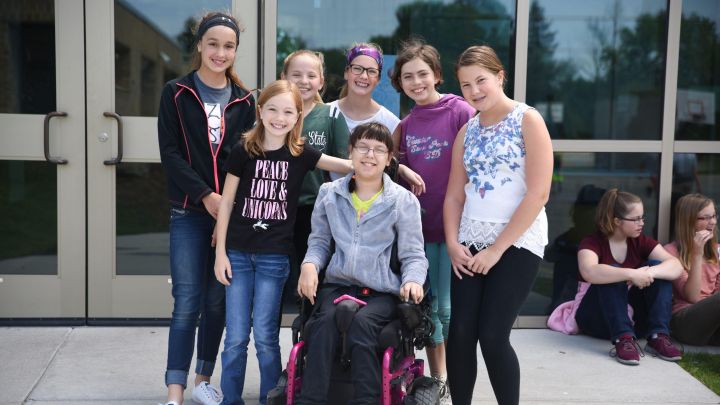Behavior Management 101
Kelsey’s story, that of a student who brings challenging behavior to school, is told and retold each day in schools throughout our country. Young students tell the story when they do not follow classroom routines and rules, and when they do not comply with expectations. Her story is told by older students, who, like Kelsey, run afoul of school codes of conduct and who receive frequent suspensions and expulsions. In the documentary, Who Cares About Kelsey?, Dan Habib describes how educators and parents are left to wonder “Who cares about my kid?” and “How can I care about my kid?”
Paradigm Shift
Very often we conclude that students who bring challenging behavior to school do so because they lack motivation to change or because they willfully choose to behave poorly. We describe their challenging behavior as “making bad choices.” In this paradigm, our response to challenging behavior is to provide a consequence that will cause a student to avoid, or simply stop doing the challenging behavior. Essentially, consequences are designed to extinguish inappropriate behavior, hopefully leaving good behavior in its wake.
This paradigm is a time-honored tradition. For years we have written rules that we expect students to follow. School rules are common-sense rules designed to promote an orderly flow of educational business. And, in the face of egregious behavior, we establish zero-tolerance policies intended to eradicate negative and dangerous behavior targeted to either oneself or others. Unfortunately, statistics suggest that negative or challenging behavior has not declined; rather, the data suggest that challenging behavior has maintained a robust status or has increased (Boccanfuso and Kuhfeld, 2011; Skiba et al., 2006). Clearly, punishing students for negative behavior is making a limited positive impact at best or is even counter-productive. There is another way.
Rethinking How We Respond
In the book Lost at School: Why Our Kids with Behavioral Challenges are Falling Through the Cracks and How We Can Help Them, Dr. Ross Greene presents an important paradigm shift in responding to challenging behavior. Greene asserts two radical and critical points on which we can re-think how we respond to negative behavior, including the kind of behavior shown to us by Kelsey.
First: “Kids do well if they can.”
Greene makes the case that students know they are supposed to behave appropriately. They know they are to follow rules and that they are to comply with social norms that keep society functioning, particularly the society of a classroom and a school. He suggests that students will do well if they can, because
“doing well is always preferable to not doing well, but only if a kid has the skills to do well in the first place” (p. 11)
For many of us, this is a radical shift in how we interpret challenging behavior.
Second: Lagging Skills
Greene suggests that students present challenging behavior because they lack the skills required to function in a particular situation. Greene calls these “lagging skills” and when we understand which skills a student lacks, we will be better able to
- Anticipate situations where the challenging behavior will likely occur;
- Teach the student the lagging skills, thereby equipping him or her to function in the situation. Greene describes challenging behavior as maladaptive behavior, meaning the behavior is not appropriate for the situation. Put another way, challenging behavior is behavior that occurs when the demands of the situation (or the task) exceed the student’s capacity to respond. When that situation arises multiple things can happen, including:
- Resorting to a challenging or maladaptive behavior that has been used before, because no other option is known to exist in the student’s repertoire
- Or “choosing” challenging behavior, because the student has no other behavior option from which to choose (such as a behavior that is adaptive or appropriate to the situation).
Challenging behavior is behavior that occurs when the demands of the situation (or the task) exceed the student's capacity to respond.
Behavior as a Skill Set
Greene tries to get us to see challenging behavior as a lack of skill so that we rethink our response to it. Viewing behavior as a set of skills required to navigate the world of social interactions opens us up to consider that challenging behavior represents a lagging skill set that must be taught or retaught. If we want maladaptive behavior to become adaptive, we must teach the student the missing skills.
Just as beliefs about classroom teaching have changed over the years, so has the idea of teaching associated with teaching lagging skills that lead to behavior. In Greene’s model of teaching lagging skills, he makes the case that students and adults must work cooperatively to solve the problem of challenging behavior. While Greene has worked out this model in considerable detail, for our purposes it includes the following elements:
- Empathy: Here the adult seeks to find out why the student is engaging in this behavior. The adult starts a conversation with some form of the observation and question, “I noticed … What’s Up?”
- Problem Definition: In this step, the adult and the student each identify their problem. Both problems must be on the table for both participants to own the partnership of the problem solution.
- Invitation: Brainstorming potential solutions to solve both problems. Both problems must be addressed, not solely the problem identified by the adult.
- Summary: “I heard us say …” and “When shall we begin?” and “Do we think this will work?” are three questions that highlight this part of the model.
Greene argues that if we are to help students make enduring changes to their challenging behavior, we must engage them in the process of learning new skills for troublesome situations, just as we teach reading or mathematics by using methods that engage students as active participants and constructors of new learning.
In Kelsey’s story, she reports that she is a “… mean person …” supposing that she is mentally disabled …” I wonder whether and how her teachers or her parents would support Kelsey if they reframed their response to her challenging behavior as a result of “lagging skills.” Instead of suspending and expelling her from school, what would have been the impact if adults who attempted to support her throughout her school career had interpreted her challenging behavior as an example of demands that exceed her capacity to respond, rather than as bad choices on her part? What if they had worked with Kelsey to identify the situations and associated lagging skills that led to maladaptive behavior?
The problem of challenging behavior is not new. Challenging behavior has been challenging for many years. Our approach to creating positive and supportive communities of learning for all students reflects our beliefs about students, behavior, and choices. Our practices in responding to challenging behavior will determine whether we give the gift of true change to students or whether we focus our efforts on managing challenging behavior.

Phil Stegink
Teacher Consultant, Special Projects
Phil Stegink works on special projects for All Belong and is an assistant professor of special education at Calvin College.
